 |
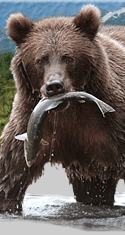 |
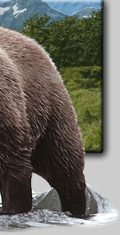 |
||||||||
 |
 |
 |
 |
|||||||
| Text by Robin Barefield
Photos by Mike Munsey , Robin Barefield, and Ryan Augustine |
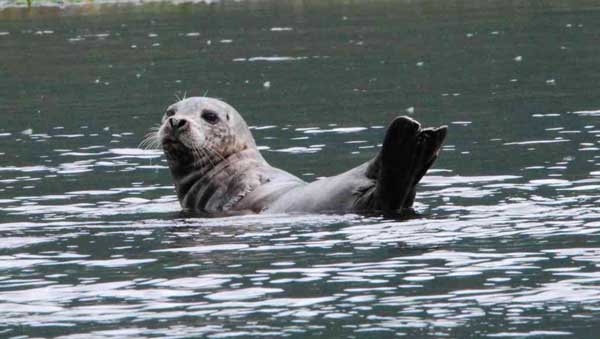 |
|
Harbor seals (Phoca vitulina) are found in both the North Atlantic and North Pacific oceans and are the most widely-distributed species of seals. They are members of the order Pinnipedia, which includes sea lions, and walruses, and they are in the family Phocidae, or the “true seals”. Members of this family lack external ear flaps (unlike sea lions), have a round or fusiform body, and have a fused pelvic girdle, which prevents them from rotating their hind flippers forward.[1] There are five, geographically-isolated subspecies of the species Phoca vitulina. The Eastern Atlantic harbor seals (Phoca vitulina vitulina) are found in Svalbard, Iceland, the British Isles, and from Norway to France;[2] Western Atlantic harbor seals (Phoca vitulina concolor) are distributed from Eastern Canada to Greenland to New Jersey;[2] Eastern Pacific harbor seals (Phoca vitulina richardii) range from the Aleutian and Pribilof Islands in Alaska to Baja California;[2] Western Pacific harbor seals (Phoca vitulina stejnegeri) can be found from the western Aleutian and Commander Islands to Kuril Island and Hokkaido;[2] and Ungava seals (Phoca vitulina mellonae) live in the freshwater lakes and rivers on the Ungava Peninsula in northern Quebec.[2] In Alaska, harbor seals of the subspecies Phoca vitulina richardii can be found from Dixon Entrance north to Kuskokwim Bay and west to the Aleutian Islands.[3] Harbor seals usually stay near shore and rarely travel more than 15.5 miles (25 km) from land, but individual seals have been spotted near the continental shelf margin.[3] From 1992 to 1997, as part of the Exxon Valdez Oil Restoration Studies, biologists attached satellite-linked depth recorders to harbor seals in Prince William Sound to study their movements. Results from 49 adult and sub-adult seals showed that adults mostly fed within 6.2 miles (10 km) of their haul-out sites, and most juveniles fed within 15.5 miles (25 km) of their haul-outs; although, some sub-adults traveled as far as far as 186 to 310 miles (300 to 500 km).[4] Harbor seals in Alaska can also be found in rivers and lakes, mostly on a seasonal basis; although, Lake Iliamna on the Alaska Peninsula hosts a permanent resident population of seals.[3] Estimates vary greatly for the number of harbor seals worldwide, mainly because seals are difficult to count. At any time, a certain segment of the population is out of the water at haul-out sites, while the rest of the seals are under water. Those hauled out are easy to count, but it is impossible to know exactly what percentage of the total population they represent. Researchers in Alaska do two things to obtain a more-reliable population estimate. First of all, they conduct their population counts during the molting season when most harbor seals haul out for several hours a day. Secondly, they tag a number of seals in an area before conducting a survey. When they count the seals, they record the number of tagged seals present, and this provides a correction factor. For example, if they tag ten seals but only count six, they increase their counts by 40% to estimate the total population in the area.[3] This technique works well in Alaska, but it is not used everywhere in the world where harbor seal populations exist, so worldwide population estimates are only a guess. Most sources agree that there are more than 200,000 harbor seals in the world,[5] and the global population is probably between 300,000 and 500,000 animals.[1] |
|
Estimates for the Eastern North Pacific population of Phoca vitulina richardii range as high as 285,000 individuals, and in Alaska, there are an estimated 141,000 harbor seals in non-glacial sites and an additional 15,000 individuals in glacial fjords.[3] While the global harbor seal population is considered healthy, there has been a dramatic decline in harbor seals in Alaska since the mid 1970's. Tugidak Island south of Kodiak Island at one time had one of the largest concentrations of harbor seals in the world, but that population dropped from 11,000 seals in 1976 to only 1000 seals in 1988, a decline of 88%. During the same time period, there was an estimated 66% decline in harbor seals on the east side of Kodiak Island.[7] Harbor seal numbers dropped 63% in Prince William Sound from 1984 to 1997, and numbers have declined more than 65% in Glacier Bay since the 1990's. Research in Prince William Sound and on Kodiak between 1983 and 1999 indicated that harbor-seal numbers have stabilized and are slowly increasing in both areas but are still much lower than they once were.[7] Unfortunately, seal numbers continue to rapidly decrease in Glacier Bay. Because of these declines, harbor seals in Alaska are listed as an Alaskan “Species of Special Concern.” This designation is assigned to any species or subspecies of a fish or wildlife population native to Alaska that is in a long-term decline or is vulnerable to a long-term decline in numbers.[3] Perhaps most troubling is that it is unclear why populations of harbor seals and other pinniped species in Alaska have decreased in recent years. It is probable that many factors have contributed to the decline, including commercial harvests, conflicts with fishermen, predation, changes in food availability, contaminants, diseases, and environmental changes,[5] but none of these factors seem to account for the precipitous decline since the 1970's. |
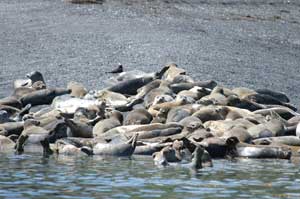 |
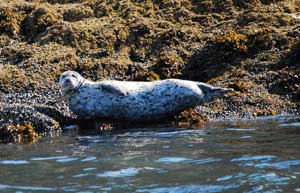 |
A harbor seal’s torpedo-shaped body is covered with stiff hair. Its coat actually has two types of hair, the bristle-like guard hairs and finer, denser under hair. The density of a seal’s hair increases with age. Glands in the skin secrete oils which help to waterproof the hair, but the hair provides no insulation. Seals molt, or shed all their hair, every year in the summer after the breeding season and then grow new coats.[1] Harbor seals vary greatly in coloration, and it is believed that the pattern of rings and spots on each seal is unique to that individual, much like a human’s fingerprints.[8] These unique patterns make it easy for biologists to differentiate between individual seals when they are studying them. Generally, the coloration follows two different patterns; either a light gray body with dark blotches or spots, or a dark body with light rings.[3] Harbor seals have a small, round head, large eyes, a short muzzle like a dog, and nostrils that appear V-shaped when viewed from the front.[6] They lack external ear flaps like those of fur seals and sea lions but instead have a small hole or external pinnae that opens to the ear canal.[3] The sensory organs for harbor seals, as well as for other pinnipeds, have evolved to function in both air and water.[9] Their large eyes and sensitive whiskers enable them to feed at great depths in dark water. The lenses of their eyes are enlarged and are adapted for focusing in water as well as in air. Their underwater vision is better than a human’s, but they don’t see quite as well as a human above water.[1] Their pupils contain a large number of rod cells, which are photoreceptor cells that are sensitive to low light but don’t allow color vision. Under water, a harbor seal’s pupils dilate to let in as much light as possible, and the tapetum lucidum, a reflecting layer behind the retina, reflects light back through the retina to maximize the light-gathering ability of the rod cells.[1] While in air, mucous constantly washes over the eyes to protect them, and since pinnipeds, in contrast to most land mammals, do not have a duct to drain eye fluids into the nasal passages, the mucous drips out of the eyes, causing wet spots around the eyes.[8] |
|
Despite their excellent eyesight under water, vision is apparently not necessary for a harbor seal to survive since biologists have found blind but otherwise healthy harbor seals.[1] These seals must rely on their other senses, including their acute sense of smell and the tactile sensitivity of their vibrissae (whiskers). Each vibrissa can move independently to detect vibrations, and a well-developed nerve system transmits this information to the brain. Under water, a harbor seal pushes its lower lip in and out to sweep the vibrissae from side to side.[1] Since harbor seals spend much of their time in the water, their nostrils are naturally shut and must be pushed open to inhale.[8]Harbor seals have very good hearing under water, but it is not as good on land.[1] When diving, external ear openings close.[8] |
|
Since a harbor seal’s pelvic bones are fused, it is impossible for it to move its hind flippers under its pelvis to walk on land, and it must awkwardly undulate like a catepillar to move when on shore. In the water, though, harbor seals use their small fore flippers as rudders and clasp both, splayed hind flippers together and gracefully propel themselves through the water by moving the hind flippers from side to side.[3] The first and fifth digits of the hind flippers are elongated to aid in propulsion.[1] Harbor seals are able to swim forward and upside down.[1] Both the fore and hind flippers are covered with hair and have claws that are used for scratching, grooming, and defense.[1] They also have a short, flat tail that is tucked between the hind flippers.[8] Harbor seals have a thick layer of blubber that insulates the seal and can be metabolized for energy. In the winter, blubber may account for as much as 30% of a seal’s total body mass,[1] and it is so efficient at insulating that while a seal’s skin is about the same temperature as the surrounding ocean water, its core remains at approximately 100EF (37.78EC)[8]. Harbor seals also have a higher metabolic rate than similar-sized land mammals, and this helps them generate more body heat.[1] In cold water, a seal’s blood is shunted to core organs, while the blood vessels in the skin constrict, reducing heat loss. When a seal is hauled out on land, the blood vessels in the skin dilate so that heat can be released from the body. Finally, to prevent heat loss through the flippers, a seal holds them close to its body.[8] |
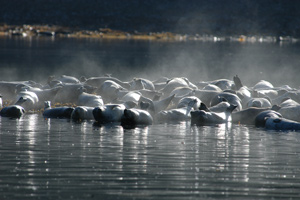 |
|
When diving, harbor seals simply sink below the surface, instead of porpoising clear of ver twenty minutes, but they normally dive less than 65 ft. (20 m) and stay down for fewer than four minutes.[3] Several physiological adaptations allow seals to dive deep and stay submerged so long. When it dives, a harbor seal’s heart rate slows from 75 to 120 beats per minute to just four to six beats per minute.[1] Blood is shunted from the peripheral tissues that can tolerate low levels of oxygen and is sent to the heart, brain, and tissues that must have a constant supply of oxygen to survive.[1] Before a deep dive, seals exhale several times to collapse their lungs, and oxygen is then stored in the blood and muscle tissues instead of in the lungs.[1] Harbor seals have a greater volume of blood than land mammals of the same size, and seals also have ten times more myoglobin than humans. This oxygen-binding protein helps prevent muscle oxygen deficiency.[1] Harbor seals can sleep either on land or in the water. In the water, they sleep with their bodies submerged and just their heads exposed in a posture known as “bottling”.[1] |
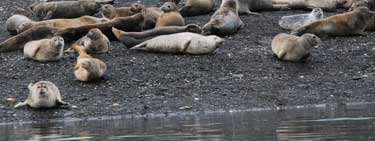 |
Harbor seals are considered the least-vocal of all pinnipeds, and most of their vocalizations take place under water. On land, they may hiss, snort, growl, or sneeze when threatening another seal.[1] Pups are more vocal than adults, and their cries are uniquely distinctive to their mothers.[1] Under water, males vocalize as part of a mating display.[1] In addition to vocal communication, harbor seals communicate visually by slapping the water with their bodies or pectoral flippers to show aggression. Males may also use this maneuver during courtship.[1] A harbor seal may wave a fore flipper to threaten another seal or show aggression by head thrusting, a rapid extension and retraction of the neck. Despite all these aggressive displays, though, fights are rare among harbor seals, except during the mating season when two competing males may fight,[1] but when fights do occur, they can be serious and bloody. |
|
Adult harbor seals are solitary and rarely interact with other seals except to mate.[1] They are curious but elusive and will often surface several times near a boat only to disappear beneath the surface if they attract too much attention. Harbor seals often do haul out of the water in loosely-organized groups, although it is not uncommon to see one seal hauled out by himself. Perhaps the main reason they usually haul out in groups is that there is safety in numbers. Studies show that seals hauled out in groups spend less time turning their heads back and forth to scan for danger than those hauled out alone.[10] When hauled out, harbor seals often assume a banana-like pose with their heads and flippers elevated off the ground. They usually do not touch each other when hauled out, and if one seal is touched by another, it often responds by growling, snorting, head-thrusting, flipper-waving, and even scratching and biting.[1] Young seals are more likely to interact with each other, and they remain on the fringes of the hauled-out group and away from the adults.[1]
|
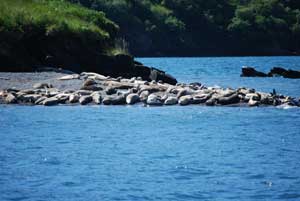 |
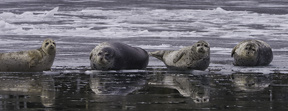 |
Research indicates that harbor seals have favorite haul-out sites that they return to regularly, and these may include beaches, sandbars, reefs, rocky shores, piers, and ice floes. Popular haul-out sites are where seals are safe from land predators, are close to a food source, are protected from wind and waves, and a place where they have access to deep water so they can quickly escape if they feel threatened.[2] Studies show that during most of the year, harbor seals haul out for an average of seven hours a day, but when they are molting, they haul for an average of twelve hours per day. During the molting season, a seal’s metabolism is reduced, so it does not need to spend as much time in the water foraging for food. (Photo by Ryan Augustine) |
|
Harbor seals are opportunistic feeders that eat fish, crabs, octopus, and squid. In Alaska, their prey include walleye pollock, Pacific cod, capelin, eulachon, Pacific herring, sandlance, Pacific salmon, sculpin, flounder, halibut, octopus, and squid.[3] Seals have sharp teeth, but they usually tear their food into chunks or swallow it whole.[1] They use their back molars to crush shells and crustaceans.[2] Seals usually obtain their water from their food, but if they don’t have enough food, they can metabolize their fat to produce water. The metabolism of 1 lb. (.45 kg) of fat produces 1.4 lbs. (.64 kg) of water.[1] There is no sexual dimorphism in harbor seals as there is for some other species of pinnipeds.[9] Mature male harbor seals reach 4.6 to 6 ft. (1.4 to 2.0 m) and weigh 154 to 375 lbs. (70 to 170 kg), and adult females range from 3.9 to 5.6 ft. (1.2 to 1.7 m) and weigh between 110 and 331 lbs. (50 to 150 kg).[1] In the Gulf of Alaska, adult males weigh an average of 190 lbs. ( 87 kg) and are 5 ft(160 cm) long. An average adult female weighs 148 lbs. (65 kg) and is 5 ft. (148 cm) in length.[5] |
|
Male harbor seals reach sexual maturity between the ages of three to seven years at a weight of 165 lbs. (75 kg). Females are sexually mature at three to six years at a weight of 110 lbs. (50 kg).[1] Unlike most other species of seals, mating for harbor seals primarily takes place in the water.[2] Females come into heat six weeks after giving birth and approximately two weeks after weaning their pups.[1] In Alaska, mating usually occurs in the late summer or fall.[11] Even prior to the pupping season, males and females exhibit pre-mating behavior such as rolling, bubble blowing, and mouthing each other’s necks. This behavior ends once the pupping season begins.[1] After the pupping season ends, males initiate mating behavior by chasing females, biting their necks and flippers, and embracing. Females may respond by growling, head thrusting, and flipper waving.[1] Males often compete with each other by performing underwater displays and vocalizations, particularly at times when females are likely to be in the water. Males also fight during this time, and it is common to see males with neck wounds. Scientists suspect that males maintain underwater territories, and they often lose up to 25% of their body weight from the energy expended from competing and breeding.[2] Copulation usually takes place in the water, and a male may mate with several females.[1] |
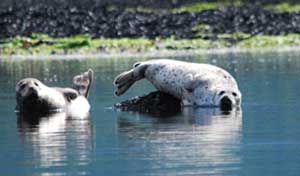 |
|
Harbor seals have a total gestation period of nine to eleven months, but like many other mammals, they have a period of delayed implantation, when the fertilized egg divides into a hollow ball of cells one layer thick called a blastocyst and then stops dividing and remains free-floating in the uterus. Delayed implantation in harbor seals lasts approximately eleven weeks until the blastocyst implants on the uterine wall and continues to grow. Actual fetal development takes about eight-and-one-half months.[3] Researchers suspect that implantation of the blastocyst may be induced by hormonal changes at the end of the molting season.[1] Delayed implantation not only gives the mother time to recover from her previous pregnancy, but it also ensures that the pup will be born when environmental conditions, such as temperature and food availability, are optimal for it to survive. Pupping in Alaska usually occurs from May through June.[4] Harbor seals typically give birth to one pup each year. Twins sometimes occur, but since the mother can only care for one pup, one of the twins will not survive.[8] Unlike many species of pinnipeds, harbor-seal births are not restricted to a few different rookeries but may occur at any haul-out site.[3] Females may also give birth on ice or in the water near shore.[1] |
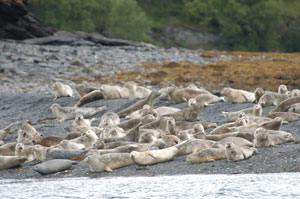 |
At birth, pups in Alaska average 22 lbs. (10 kg) and are 2.5 ft. (82 cm) long.[5] Pups are well-developed at birth and must be able to swim only a few hours later to ensure they survive the next high tide.[6] Mothers care for their pups for four to six weeks. A female harbor seal has two mammary glands on her lower abdomen and may nurse either on land or in the water.[1] She is very attentive to her pup during this period and often “noses” the pup. The mother recognizes her pup by vocalizations and by smell.[1] A pup may ride on his mother’s back when he’s tired, and he will nip at his mother’s flippers and chase her through the water.[1] Unlike most other seal species where the mother fasts while nursing, harbor-seal mothers leave their pups for short periods of time during the nursing season to find food. Researchers believe harbor seals must continue to eat while nursing, because they do not have enough fat on their relatively small bodies to withstand fasting.[1] Harbor-seal milk contains approximately 45% fat, 9% protein, and 45.8% water. Because of this high fat content, pups more than double their weight by the time they are weaned.[1] Once the pup is weaned, the mother shows no interest in him, and a pup soon learns how to catch and eat bottom-dwelling crustaceans, and later he learns how to catch fish. He stays near adults during this time.[1] The age of a harbor seal can be determined by examining a sliced section of a tooth under a microscope and counting the growth rings in the dental material.[1] This technique has allowed researchers to determine that males have a maximum life span of 26 years, and females may live as long as 35 years.[3] Males possibly have a shorter life span because of the stress of fighting during the breeding season.[1] Pup mortality is 21% during the first year. Pups may be abandoned, starve, wash away from pupping areas during high seas, or die from injury or illness.[1] |
|
Harbor seals are susceptible to a variety of parasites that may attack the heart, lungs, blood vessels, stomach, intestines, and skin. In 1988, a viral epidemic (phocine distemper virus) in northern Europe killed more than 18,000 harbor seals and reoccurred in the same area in 2002 killing 10,000 to 30,000 seals.[1] A virus similar to bovine pneumonia was blamed for the sudden death of over one-hundred seals in Point Reyes, California in 1997.[1] |
|
In Alaska, the most common predators of harbor seals are orcas, Stellar sea lions, and sharks. Eagles may prey upon pups, and bears, wolves, and coyotes may prey upon seals hauled out on land.[3] Before the Marine Mammal Act was passed in 1972, harbor seals were commercially hunted in Alaska and were also killed to reduce their predation on salmon or for damaging commercial-fishing gear. Even after the Marine Mammal Protection Act was passed, fishermen were still allowed to shoot seals if they were damaging their gear and could not be deterred in any other way. In 1994, the Marine Mammal Protection Act was amended, allowing fishermen to use only non-lethal means to keep seals and other marine mammals away from their gear.[4] Today, only Alaskan natives are allowed to hunt harbor seals, since seals have historically played an important role in their culture and diet.[3] Harbor seals are sometimes killed or injured in gill nets and crab pots.[3] Marine debris is also a threat to seals, and ingestion of plastic waste can cause starvation or obstruct the digestive tract.[1] Seals are vulnerable to toxic chemicals in areas with industrial runoff,[1] and they are susceptible to oil spills and other forms of pollution. It was estimated that three-hundred harbor seals died as a result of the 1989 Exxon Valdez oil spill in Alaska, but this is just an approximation based on the percentage decline in seal numbers at oiled haul-out sites versus the decline in numbers at non-oiled haul-outs.[4] |
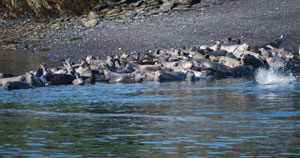 |
|
References Cited 1. Harbor Seal. Seaworld Parks & Entertainment. Available at: seaworld.org/en/animal-info/animal-infobooks/harbor-seal/. 2. Harbor Seals, Phocavitulina.MarineBio Conservation Society. Available at: marinebio.org/species.asp?id=158. 3. Harbor Seal (Phocavitulina). Alaska Department of Fish and Game. Species Profile. Available at: www.adfg.alaska.gov/index.cfm?adfg=harborseal.main. 4. Mundy, Phillip R. 2005. The Gulf of Alaska Biology and Oceanography. Alaska Sea Grant College Program, University of Alaska Fairbanks. 5. Harbor Seal Species Description. Alaska SeaLife Center. Window to the sea. Available at: www.alaskasealife.org/new/research/index.php?page=harborsealresearch.php. 6. Cresswell, Graeme, Dylan Walker, and Todd Pusser.2007. Whales and Dolphins of the North American Pacific including Seals and other Marine Mammals. Harbor Publishing. IBN: 978-1-55017-409-0. 7. Small, Robert J. 2001. Harbor Seal Investigations in Alaska, Annual Report. NOAA Grant NA87FX0300. Available at: www.arlis.org/docs/vol.1/48251783.pdf. 8. Harbor Seal Fact Sheet with Emphasis on Phocavitulinarichardsi. Available at: www.palomar.edu/oceanography/harbor_seals/facts.htm. 9. Wynne, Kate. 2007. Guide to Marine Mammals of Alaska. Alaska Sea Grant College Program, University of Alaska Fairbanks. ISBN 1-56612-121-3. 10. Harbor Seal (Phocavitulina). NOAA Fisheries Office of Protected Resources. Available at: www.nmfs.noaa.gov/pr/species/mammals/pinnipeds/harborseal.htm. 11. Harbor Seal. Alaska Zoo. Available at: alaskazoo.org/harbor-seal. |
Copyright 2012 Munsey's Bear Camp